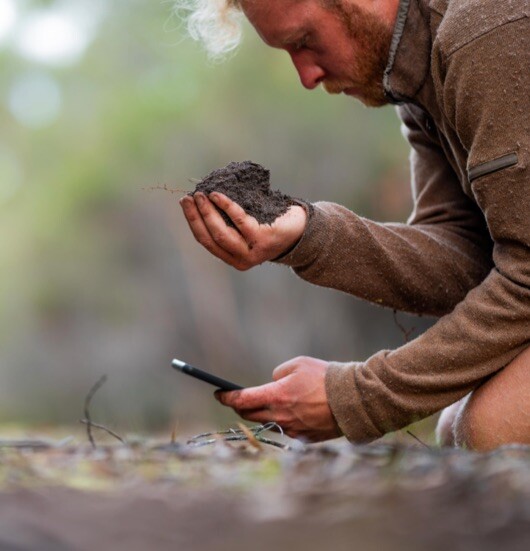Getting the most out of your farm data
Collecting data that you can use to make decisions is key.

Key messages
- Always have a clear purpose for collecting on-farm data and understand how it can be used to make decisions, for example informing fertiliser strategies, livestock breeding programs and soil amelioration
- Good quality data is critical to making informed decisions
- Ensure that you will be able to access your data, even when changing consultants or machinery suppliers
Riverine Plains recently hosted a webinar to help farmers get the most out of their farm data. The webinar featured Riverine Plains’ members, James Russell and Adam Davis, who shared insights into their use of farm data, collected from regular soil testing and farm trials, to monitor and improve farm business management.
The importance of good quality data - a farmer perspective
Adam Davis and James Russell highlighted the importance of collecting good quality data and having a clear purpose or plan for the data being collected on-farm.
Adam Davis uses farm data to increase efficiency on-farm but stressed that data strategies are specific to each farm and what works for your neighbour may not necessarily work best for you. Adam employs a variable rate fertiliser strategy for lime, gypsum, nitrogen and phosphorus and uses NDVI imagery, yield and soil mapping data to ensure optimal fertiliser rates are applied in each paddock. Deep soil nitrogen testing and EM mapping are also important data sources to drive decisions, particularly in relation to nitrogen application in his lucerne-based pastures.
James Russell agreed that data collection is key to enhancing farm management. He stressed the usefulness of collecting soil testing data and using precise GPS coordinates to ensure soil tests are taken from the same place every year. James uses data from soil testing to drive management decisions, such as for liming programs, as well as macro and micronutrient applications. He also uses elevation mapping programs to develop strategic drainage maps. These have been extremely useful during recent, wet years on his mostly flat and heavy soils.
James also highly recommended using on-farm trials. The data from yield maps, NDVI images and cost-benefit ratios produced from the trial results are all specific to a particular farm, paddock and crop. Finally, James recommended using an app to keep track of all grain stored on-farm and delivered to any facilities (some apps, can also be used by drivers and operators).
There’s an app for that; working out which app meets your needs
Working out which app to use for a specific farm data purpose can be tricky. Adam suggested farmers identify the five main things they want to gain from using an app and then allow a fortnight to test out potential apps. If, at the end of the two weeks all five items can’t be ticked off the list, he recommended farmers keep searching. Adam also advised that the focus shouldn’t just be narrowed to apps that have the word ‘agriculture’ in the name; the data and tech space is vast and there are plenty of products used in other industries that can be useful in agriculture. When it comes to apps there are plenty of options and the further you dig, the more options you’ll find.
It was also recommended farmers reach out to the support services offered by an app, to learn how to get the most from their app experience.
Who owns your farm data?
As farm equipment and technology becomes increasingly sophisticated, more farm data is being collected by machinery companies and sold to third parties, often without farmers’ knowledge.
Professor Leanne Wiseman, Griffith University, explained the concept of ‘data portability’ as it relates to farmers being able to access their farm data from machinery companies, consultants and other third parties whenever they require it. Unfortunately, this is often not the case and examples were given where farmers have been unable to access their data from machinery companies when switching brands. Another common scenario is when a local agronomist sells their business to a larger organisation, taking all the farmer client data with it, so that farmers can no longer access their own data.
To avoid such situations, Professor Wiseman strongly recommended farmers have early conversations with any consultant, advisor, agronomist or equipment dealer they are considering sharing their data with. This will help clarify who will have access to your data and help ensure your data will always be accessible by you. She also suggested that best data practice is where machinery dealers and consultants have an open dialogue with farmers about any data sharing terms and conditions before contracting. When it comes to data sharing contracts, transparency between parties is extremely important to understand exactly how data will be used.
Sometimes when switching machinery brands, a company may say they are unable to transfer all data across. In such situations, it was highly recommended that farmers continue to apply pressure on the company to transfer all data across (e.g. yield maps), even if they claim they are unable to do so.
This project received grant funding from the Australian Government.
Where to get more information
To learn more about using on-farm data, join us as we explore the topic “Putting farmers first – driving decisions using data” at the upcoming Riverine Plains Innovation Expo from Thursday 24 – Friday 25 August 2023 at the Yarrawonga Mulwala Golf Club Resort.
The Expo will focus on helping farmers future-proof and proactively manage their businesses in a rapidly changing global market.
Author
Kate Coffey
Senior Project Manager Bachelor of Agricultural Economics, Grad Diploma in Financial Administration
14 July 2023
NEWS
Keep up to date with the latest news from across the Riverine Plains.
-
Livestock
-
People
-
Grains
-
Sustainability

